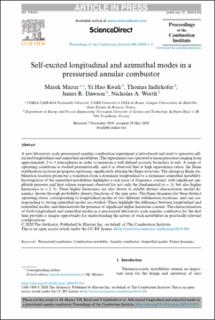| dc.contributor.author | Mazur, Marek | |
| dc.contributor.author | Kwah, Yi Hao | |
| dc.contributor.author | Indlekofer, Thomas | |
| dc.contributor.author | Dawson, James | |
| dc.contributor.author | Worth, Nicholas | |
| dc.date.accessioned | 2020-08-27T06:52:56Z | |
| dc.date.available | 2020-08-27T06:52:56Z | |
| dc.date.created | 2020-08-06T10:37:03Z | |
| dc.date.issued | 2020 | |
| dc.identifier.issn | 1540-7489 | |
| dc.identifier.uri | https://hdl.handle.net/11250/2675285 | |
| dc.description.abstract | A new laboratory scale pressurised annular combustion experiment is introduced and used to generate selfexcited longitudinal and azimuthal instabilities. The experiments are operated at mean pressuresranging from
approximately 2 to 3 atmospheres in order to maintain a well defined acoustic boundary at exit. A range of
operating conditions is studied parametrically, and it is observed that at high equivalence ratios, the flame
stabilisation location propagates upstream, significantly altering the flame structure. The change in flame stabilisation location promotes a transition from a dominant longitudinal to a dominant azimuthal instability.
Investigation of the azimuthal instabilities highlights a rich array of frequency content, with significant amplitude pressure and heat release responses observed for not only the fundamental (n = 1), but also higher
harmonics (n = 2, 3). These higher harmonics are also shown to exhibit distinct characteristic modal dynamics, shown through probability density functions of the spin ratio. The flame dynamics for three distinct
operating states, corresponding to longitudinal modes at two different stabilisation locations, and one corresponding to strong azimuthal modes are studied. These highlight the difference between longitudinal and
azimuthal modes, and demonstrate the presence of significant higher harmonic content. The characterisation
of both longitudinal and azimuthal modes in a pressurised laboratory scale annular combustor for the first
time provides a unique opportunity for understanding the nature of such instabilities in practically relevant
configurations. | en_US |
| dc.language.iso | eng | en_US |
| dc.publisher | Elsevier | en_US |
| dc.rights | Navngivelse 4.0 Internasjonal | * |
| dc.rights.uri | http://creativecommons.org/licenses/by/4.0/deed.no | * |
| dc.title | Self-excited longitudinal and azimuthal modes in a pressurised annular combustor | en_US |
| dc.type | Peer reviewed | en_US |
| dc.type | Journal article | en_US |
| dc.description.version | publishedVersion | en_US |
| dc.source.journal | Proceedings of the Combustion Institute | en_US |
| dc.identifier.doi | https://doi.org/10.1016/j.proci.2020.05.033 | |
| dc.identifier.cristin | 1821972 | |
| dc.description.localcode | https://doi.org/10.1016/j.proci.2020.05.033 1540-7489 © 2020 The Author(s). Published by Elsevier Inc. on behalf of The Combustion Institute. This is an open access article under the CC BY license. (http://creativecommons.org/licenses/by/4.0/) | en_US |
| cristin.ispublished | true | |
| cristin.fulltext | original | |
| cristin.qualitycode | 2 | |

